Shoaling and Sedimentation Dynamics in Fishery Shelters: A Case Study of Sandıktaş Fishery Shelter
Abstract
1. Introduction
1.1. Fishery Shelters in Turkey
1.2. Fishery Coastal Structures in the Eastern Black Sea
1.3. The Need for Dredging in Fishery Shelters
1.4. Study Area
2. Materials and Methods
Reliability of Bathymetric Surveys
3. Results and Discussion
Statistical Analysis of Result Data
4. Conclusions
- Nearly all sediment analysis results exhibited an increasing trend, with p-values higher than 0.05 for most samples. This indicates a complex sediment transport mechanism in the region, suggesting the need for further research to develop more accurate sediment prediction models.
- Long-term measurements and analyses demonstrated that the fishery shelter undergoes continuous shoaling due to the insufficient functionality of both the main and secondary breakwaters. Despite three dredging operations conducted during the measurement period, shoaling could not be effectively prevented. Over the study period, a total sediment accumulation volume of 11,611 m3 was recorded, leading to an average reduction in water depth of 8 cm.
- Modifying the existing breakwater by extending it in a manner that disrupts the returning wave action is expected to significantly reduce shoaling effects.
Author Contributions
Funding
Data Availability Statement
Acknowledgments
Conflicts of Interest
References
- Bayraktar, E.A.; Bayraktar, D.; Yüksek, Ö. Effects of T Shaped Groins on Coasts in the Eastern Black Sea Region. SDÜ Sci. Inst. J. 2016, 20, 509. [Google Scholar] [CrossRef]
- Berkun, M.; Anılan, T.; Aras, E. Interactions of Sediment Transport and Coastal Erosion in the Eastern Black Sea Region. In Proceedings of the 8th Congress of Coastal and Marine Areas of Turkey, Trabzon, Turkey, 27 April 2010; pp. 1169–1179. [Google Scholar]
- Güner, H.A.A.; Yüksel, Y.; Çevik, E.Ö. Determination of Shoreline Evolution: A Case Study. In Proceedings of the Coastal Engineering Practice, San Diego, CA, USA, 21–24 August 2011. [Google Scholar]
- Wilson, R.; Davenport, C.; Jaffe, B. Sediment Scour and Deposition within Harbors in California (USA), Caused by the March 11, 2011 Tohoku-Oki Tsunami. Sediment Geol. 2012, 282, 228–240. [Google Scholar] [CrossRef]
- Mojabi, M.; Hejazi, K.; Karimi, M. Numerical Investigation of Effective Harbor Geometry Parameters on Sedimentation inside Square Harbors. Int. J. MAr. Sci. Eng. 2013, 3, 57–68. [Google Scholar]
- Görmüş, K.S.; Kutoǧlu, Ş.H.; Şeker, D.Z.; Özölçer, I.H.; Oruç, M.; Aksoy, B. Temporal Analysis of Coastal Erosion in Turkey: A Case Study Karasu Coastal Region. J. Coast. Conserv. 2014, 18, 399–414. [Google Scholar] [CrossRef]
- Weerasekara, K.A.W.S.; Jayampathi, O.M.M.D.; Hettige, N.D.; Azmy, S.A.M.; Amarathunga, A.A.D.; Wickramaarachchi, W.D.N.; Maddumage, M.D.S.R.; Jayawardena, J.K.P.C.; Narangoda, S.R.C.N.K.; Rajapaksha, R.M.G.N.; et al. Assessment of Water Pollution Status of Selected Fishery Harbours Located in the Southern Province of Sri Lanka. J. Environ. Prof. Sri Lanka 2015, 4, 36–46. [Google Scholar] [CrossRef]
- Gunbak, R.A.; Gokce, T.K.; Guler, I. Sedimentation and Erosion Problems of Yakakent Fishery Harbour. In Proceedings of the 23rd International Conference on Coastal Engineering, Venice, Italy, 4–9 October 1992; Volume 3. [Google Scholar]
- Süme, V. Grain Size and Beach Formation Characteristic at the T-Head Groins System at Kiyicik, Turkey (Eastern Black Sea). J. Civ. Environ. Eng. 2014, 4, 1000150. [Google Scholar] [CrossRef]
- Süme, V.; Yüksek, Ö. Investigation of Shoaling of Coastal Fishery Structures in the Eastern Black Sea Coasts. J. Fac. Eng. Archit. Gazi Univ. 2018, 33, 843–852. [Google Scholar] [CrossRef]
- Sharaan, M.; Ibrahim, M.G.; Iskander, M.; Masria, A.; Nadaoka, K. Analysis of Sedimentation at the Fishing Harbor Entrance: Case Study of El-Burullus, Egypt. J. Coast. Conserv. 2018, 22, 1143–1156. [Google Scholar] [CrossRef]
- Kudale, A.M.; Sohoni, V.S.; Patil, B.M.; Mahalingaiah, A.V. Hydraulic Modelling for the Design of Fisheries Harbours. Int. J. Civ. Eng. Technol. 2018, 9, 356–371. [Google Scholar]
- Klante, C. Sediment Transport and Bathymetric Change at Hornafjörður Tidal Inlet—Field Data Analysis and Mathematical Modeling. H2-. Master’s Thesis, Lund University, Lund, Sweden, 2018. [Google Scholar]
- Yazir, D.; Şahin, B.; Eruz, C. Evaluation of Sediment Transportation Processes in Designing Coastal Structures of Araklı. Pamukkale Univ. J. Eng. Sci. 2018, 24, 1005–1013. [Google Scholar] [CrossRef]
- Maiti, D.K.; Sundar, V.; Sannasiraj, S.A. Design of a Minor Fishing Harbor in India with Special Reference to Training of the Mouth of River Chapora. In Proceedings of the Fifth International Conference in Ocean Engineering (ICOE 2019), Madras, India, 28 July–1 August 2019; Volume 106 LNCE. [Google Scholar]
- Johnson, H.N. Sedimentation solutions for the port of Pascagoula. Master’s Thesis, Mississippi State University, Starkville, MS, USA, 2008. [Google Scholar]
- Süme, V.; Yüksek, Ö.; Şişik, E. The Granulometric Analysis of Sediments That Cause of Shoaling to Depositing in Fishery Harbours. Tur. J. Hyd. 2019, 3, 7–13. [Google Scholar]
- Süme, V.; Yüksek, T.; Kaya, A. A Case Study on the Usability of T- Head Groins as Beach at Trabzon and Rize Coasts. Gümüşhane Univ. J. Sci. Inst. 2019, 9, 610–619. [Google Scholar] [CrossRef][Green Version]
- Fernández-Fernández, S.; Ferreira, C.C.; Silva, P.A.; Baptista, P.; Romão, S.; Fontán-Bouzas, Á.; Abreu, T.; Bertin, X. Assessment of Dredging Scenarios for a Tidal Inlet in a High-Energy Coast. J. Mar. Sci. Eng. 2019, 7, 395. [Google Scholar] [CrossRef]
- Liu, H.; Xu, K.; Ou, Y.; Bales, R.; Zang, Z.; Xue, Z.G. Sediment Transport near Ship Shoal for Coastal Restoration in the Louisiana Shelf: A Model Estimate of the Year 2017–2018. Water 2020, 12, 2212. [Google Scholar] [CrossRef]
- Hao, X.; Cao, T.; Shen, L. Mechanistic Study of Shoaling Effect on Momentum Transfer between Turbulent Flow and Traveling Wave Using Large-Eddy Simulation. Phys. Rev. Fluids 2021, 6, 054608. [Google Scholar] [CrossRef]
- Karasu, S.; Marangoz, H.O.; Kocapir, B.H.; Yilmaz, E.; Özölçer, İ.H.; Akpinar, A. Monitoring Sediment Transport in Certain Harbor Launches in the Southeastern Black Sea. Water 2023, 15, 3860. [Google Scholar] [CrossRef]
- AlMashan, N.; Al-Attar, I.; Neelamani, S. Assessment of Annual Sedimentation into Failaka Marina (Kuwait) and Possible Solutions for Reduction of Siltation. J. Coast. Res. 2024, 40, 527–553. [Google Scholar] [CrossRef]
- Wang, C.; Li, Q.; Liu, Y.; Wu, G.; Liu, P.; Ding, X. A Comparison of Waveform Processing Algorithms for Single-Wavelength LiDAR Bathymetry. ISPRS J. Photogramm. Remote Sens. 2015, 101, 22–35. [Google Scholar] [CrossRef]
- Jagalingam, P.; Akshaya, B.J.; Hegde, A.V. Bathymetry Mapping Using Landsat 8 Satellite Imagery. Procedia Eng. 2015, 116, 560–566. [Google Scholar] [CrossRef]
- Bergsma, E.W.J.; Almar, R.; Rolland, A.; Binet, R.; Brodie, K.L.; Bak, A.S. Coastal Morphology from Space: A Showcase of Monitoring the Topography-Bathymetry Continuum. Remote Sens. Environ. 2021, 261, 112469. [Google Scholar] [CrossRef]
- Fan, D.; Li, S.; Feng, J.; Sun, Y.; Xu, Z.; Huang, Z. A New Global Bathymetry Model: STO_IEU2020. Remote Sens. 2022, 14, 5744. [Google Scholar] [CrossRef]
- Ashphaq, M.; Srivastava, P.K.; Mitra, D. Review of Near-Shore Satellite Derived Bathymetry: Classification and Account of Five Decades of Coastal Bathymetry Research. J. Ocean. Eng. Sci. 2021, 6, 340–359. [Google Scholar] [CrossRef]
- Evagorou, E.; Argyriou, A.; Papadopoulos, N.; Mettas, C.; Alexandrakis, G.; Hadjimitsis, D. Evaluation of Satellite-Derived Bathymetry from High and Medium-Resolution Sensors Using Empirical Methods. Remote Sens. 2022, 14, 772. [Google Scholar] [CrossRef]
- Zhong, J.; Sun, J.; Lai, Z.; Song, Y. Nearshore Bathymetry from ICESat-2 LiDAR and Sentinel-2 Imagery Datasets Using Deep Learning Approach. Remote Sens. 2022, 14, 4229. [Google Scholar] [CrossRef]
- Lubac, B.; Burvingt, O.; Nicolae Lerma, A.; Sénéchal, N. Performance and Uncertainty of Satellite-Derived Bathymetry Empirical Approaches in an Energetic Coastal Environment. Remote Sens. 2022, 14, 2350. [Google Scholar] [CrossRef]
- Salameh, E.; Frappart, F.; Almar, R.; Baptista, P.; Heygster, G.; Lubac, B.; Raucoules, D.; Almeida, L.P.; Bergsma, E.W.J.; Capo, S.; et al. Monitoring Beach Topography and Nearshore Bathymetry Using Spaceborne Remote Sensing: A Review. Remote Sens. 2019, 11, 2212. [Google Scholar] [CrossRef]
- Janowski, L.; Wroblewski, R.; Rucinska, M.; Kubowicz-Grajewska, A.; Tysiac, P. Automatic Classification and Mapping of the Seabed Using Airborne LiDAR Bathymetry. Eng. Geol. 2022, 301, 106615. [Google Scholar] [CrossRef]
- Alevizos, E.; Oikonomou, D.; Argyriou, A.V.; Alexakis, D.D. Fusion of Drone-Based RGB and Multi-Spectral Imagery for Shallow Water Bathymetry Inversion. Remote Sens. 2022, 14, 1127. [Google Scholar] [CrossRef]
- Ludka, B.C.; Guza, R.T.; O’Reilly, W.C.; Merrifield, M.A.; Flick, R.E.; Bak, A.S.; Hesser, T.; Bucciarelli, R.; Olfe, C.; Woodward, B.; et al. Sixteen Years of Bathymetry and Waves at San Diego Beaches. Sci. Data 2019, 6, 161. [Google Scholar] [CrossRef]
- Cesbron, G.; Melet, A.; Almar, R.; Lifermann, A.; Tullot, D.; Crosnier, L. Pan-European Satellite-Derived Coastal Bathymetry—Review, User Needs and Future Services. Front Mar. Sci. 2021, 8, 740830. [Google Scholar] [CrossRef]
- Duplančić Leder, T.; Baučić, M.; Leder, N.; Gilić, F. Optical Satellite-Derived Bathymetry: An Overview and WoS and Scopus Bibliometric Analysis. Remote Sens. 2023, 15, 1294. [Google Scholar] [CrossRef]
- Amini, L.; Kakroodi, A.A. Bathymetry Monitoring of Shallow Coastal Environment Using Remote Sensing Data. Remote Sens. Appl. 2024, 36, 101255. [Google Scholar] [CrossRef]
- Thom, B.G.; Hall, W. Behaviour of Beach Profiles during Accretion and Erosion Dominated Periods. Earth Surf. Process. Landf. 1991, 16, 113–127. [Google Scholar] [CrossRef]
- Westoby, M.J.; Brasington, J.; Glasser, N.F.; Hambrey, M.J.; Reynolds, J.M. ‘Structure-from-Motion’ Photogrammetry: A Low-Cost, Effective Tool for Geoscience Applications. Geomorphology 2012, 179, 300–314. [Google Scholar] [CrossRef]
- Barnard, P.L.; van Ormondt, M.; Erikson, L.H.; Eshleman, J.; Hapke, C.; Ruggiero, P.; Adams, P.N.; Foxgrover, A.C. Development of the Coastal Storm Modeling System (CoSMoS) for Predicting the Impact of Storms on High-Energy, Active-Margin Coasts. Nat. Hazards 2014, 74, 1095–1125. [Google Scholar] [CrossRef]
- Brodie, K.L.; Palmsten, M.L.; Hesser, T.J.; Dickhudt, P.J.; Raubenheimer, B.; Ladner, H.; Elgar, S. Evaluation of Video-Based Linear Depth Inversion Performance and Applications Using Altimeters and Hydrographic Surveys in a Wide Range of Environmental Conditions. Coast. Eng. 2018, 136, 147–160. [Google Scholar] [CrossRef]
- Gesto, M.; Jokumsen, A. Effects of Simple Shelters on Growth Performance and Welfare of Rainbow Trout Juveniles. Aquaculture 2022, 551, 737930. [Google Scholar] [CrossRef]
- Gazioğlu, C.; Simav, Ö.; Seker, D.Z.; Tanik, A. Determining The Endangered Fields Of Turkish Coasts With Coastal Vulnerability Index. In Proceedings of the TMMOB Geographic İnformation Systems Congress, Ankara, Turkey, 11 November 2013. [Google Scholar]
- Dolfen Engineering Ltd.; Dolsar Engineering Ltd. Fishery Coastal Structures Situation and Needs Analysis—1; Republic of Turkey Ministry of Transportation General Directorate of Railways, Ports And Airports (DLH) Construction Dolfen Engineering Ltd.: Ankara, Turkey, 2011. Available online: https://www.uab.gov.tr/uploads/pages/kutuphane/56203e35a7c75e0-5ea041c13e035.pdf (accessed on 23 March 2025). (In Turkish)
- Van Vledder, G.P.; Akpinar, A. Wave Model Predictions in the Black Sea: Sensitivity to Wind Fields. Appl. Ocean. Res. 2015, 53, 161–178. [Google Scholar] [CrossRef]
- Karasu, S.; Marangoz, H.O.; Gülkaya, E.; Akpınar, A.; Ceylan, Y.; Yılmaz, E. Performance based assessment of a small-scale artificially nourished beach. Ocean. Coast. Manag. 2023, 244, 106827. [Google Scholar] [CrossRef]
- Ozhan, E.; Abdalla, S. Wind and Deep Water Wave Atlas for Turkish Coast; METU Publishing: Ankara, Turkey, 2002; SN: 9789754291902; Available online: https://books.google.com.tr/books?id=7ViNAQAACAAJ (accessed on 23 March 2025). (In Turkish)
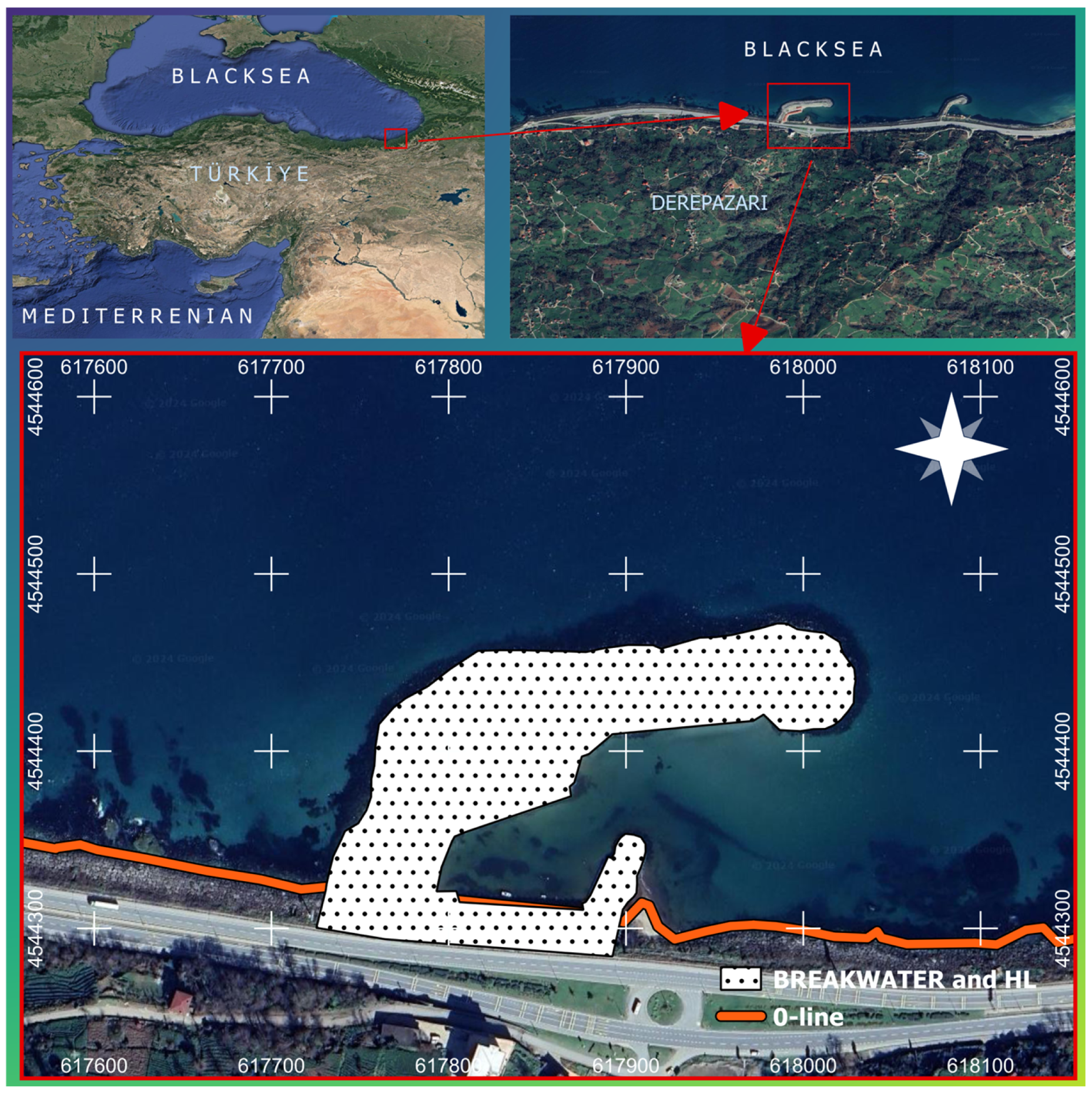
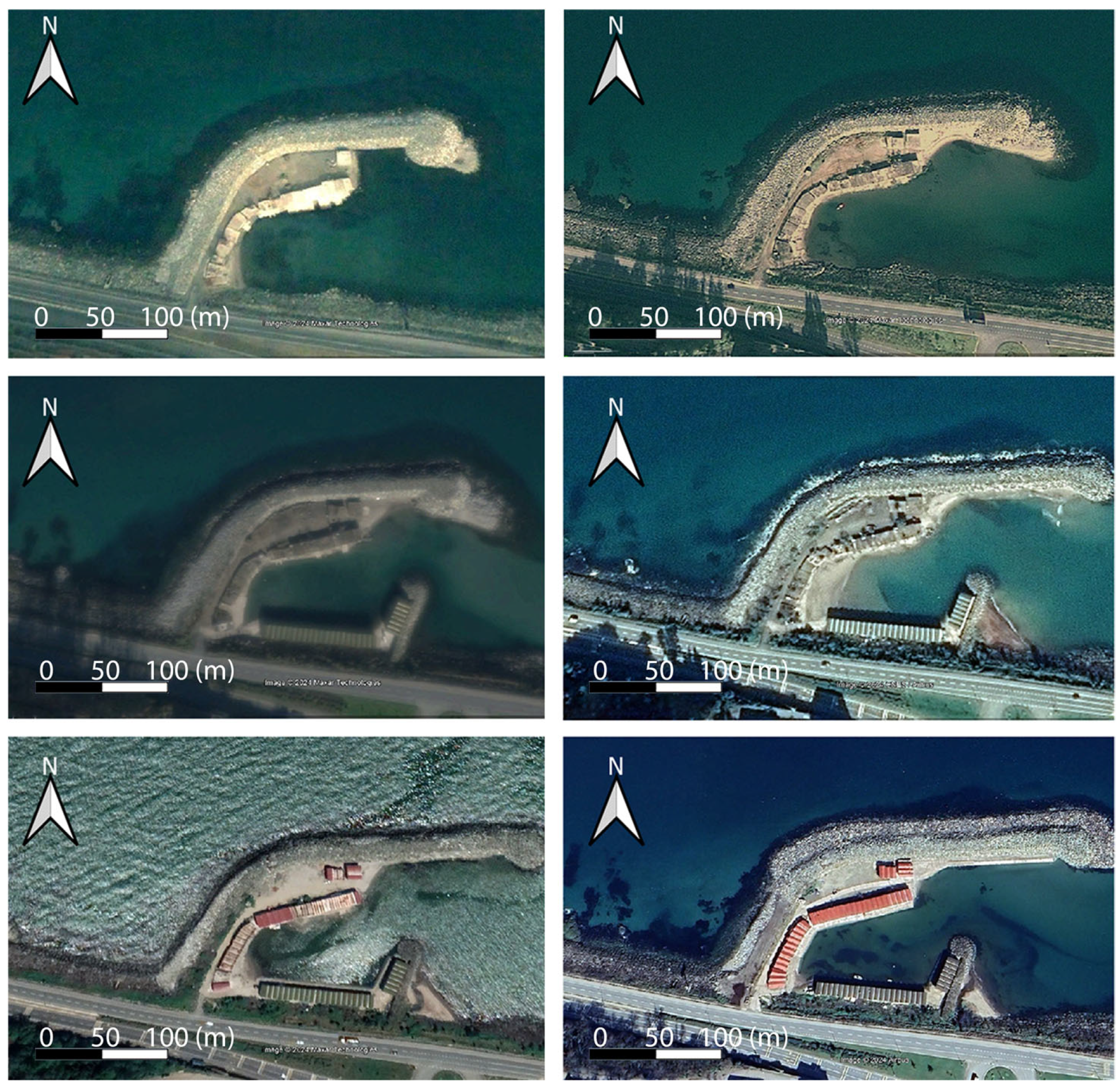

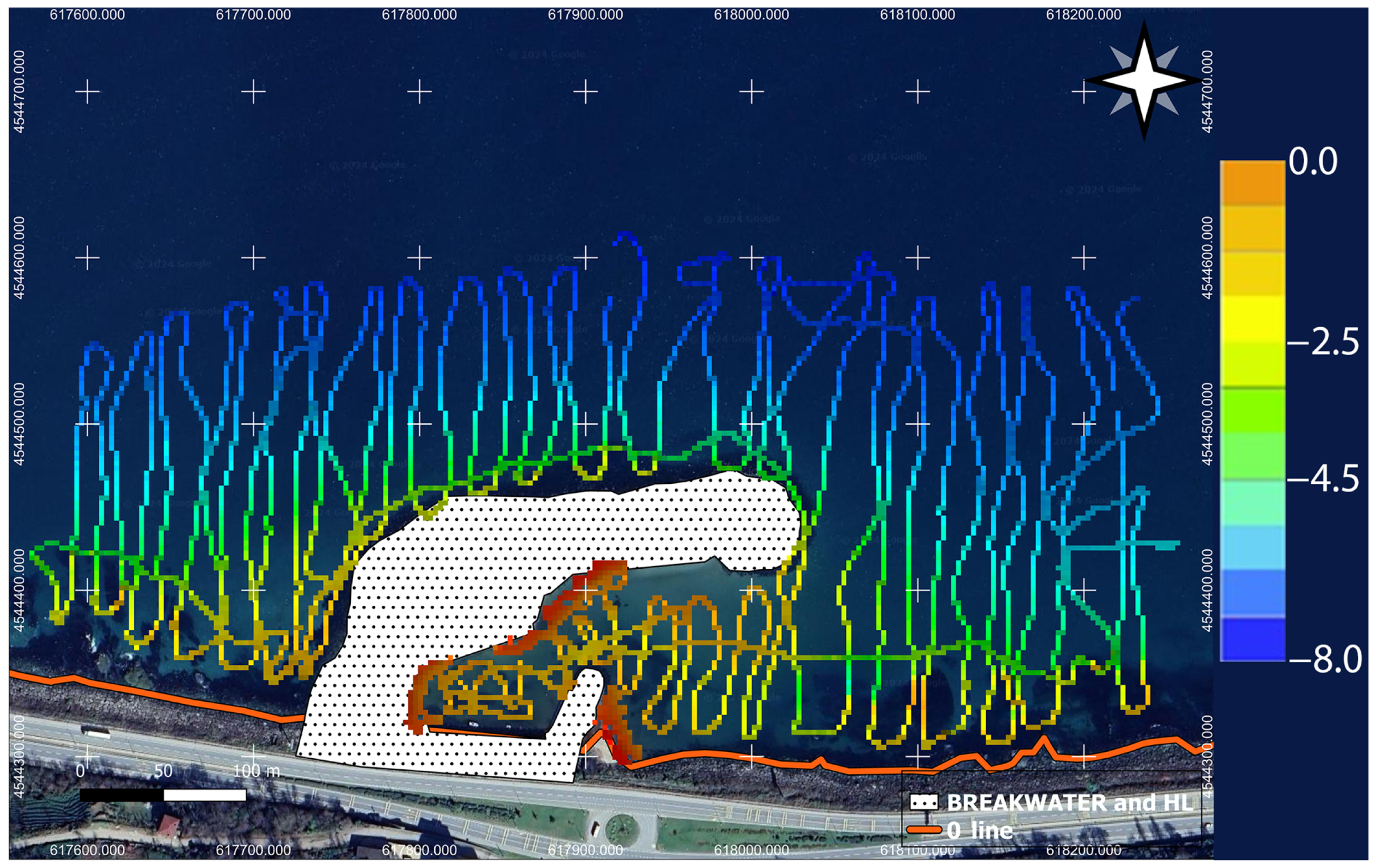
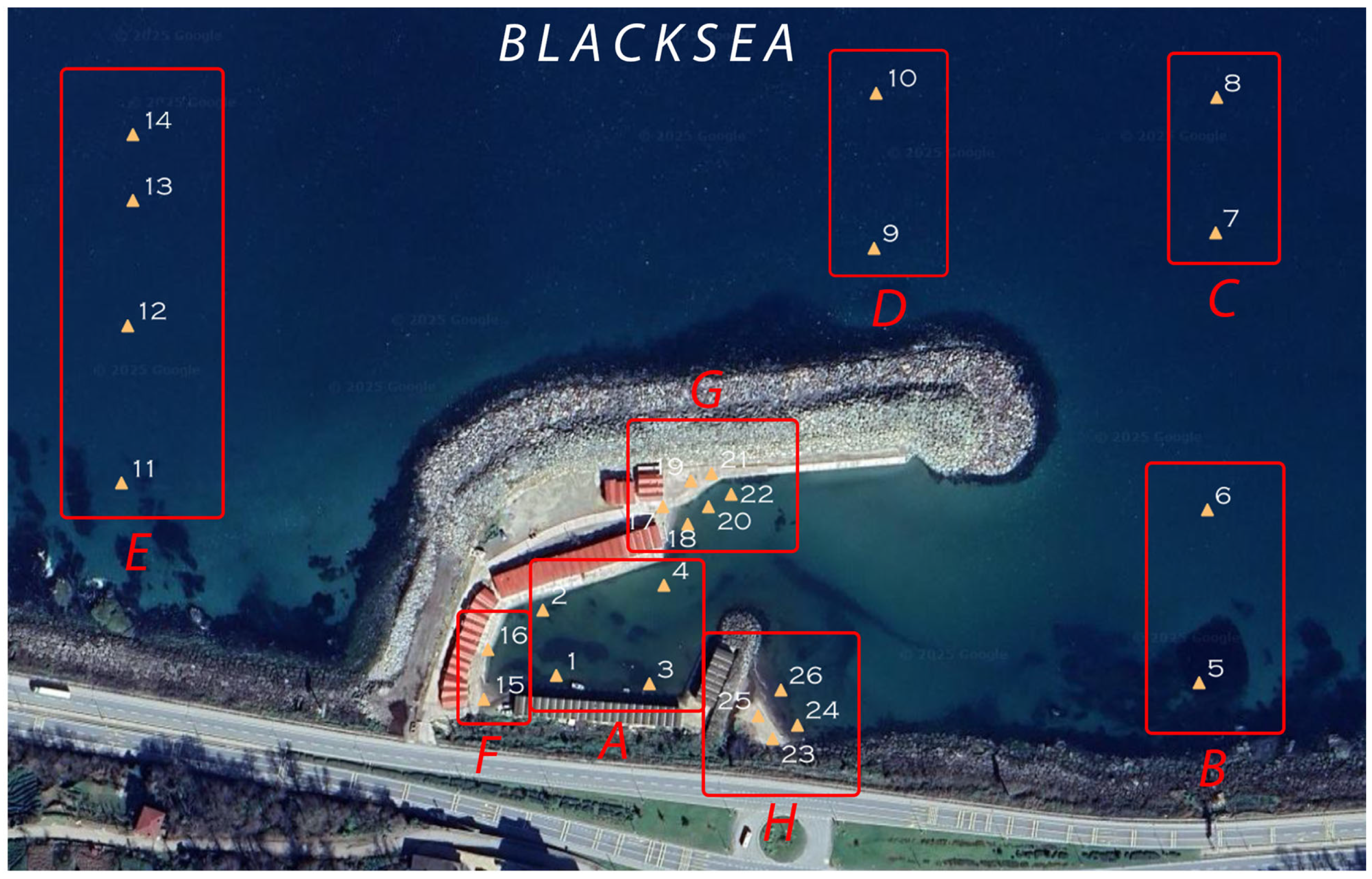
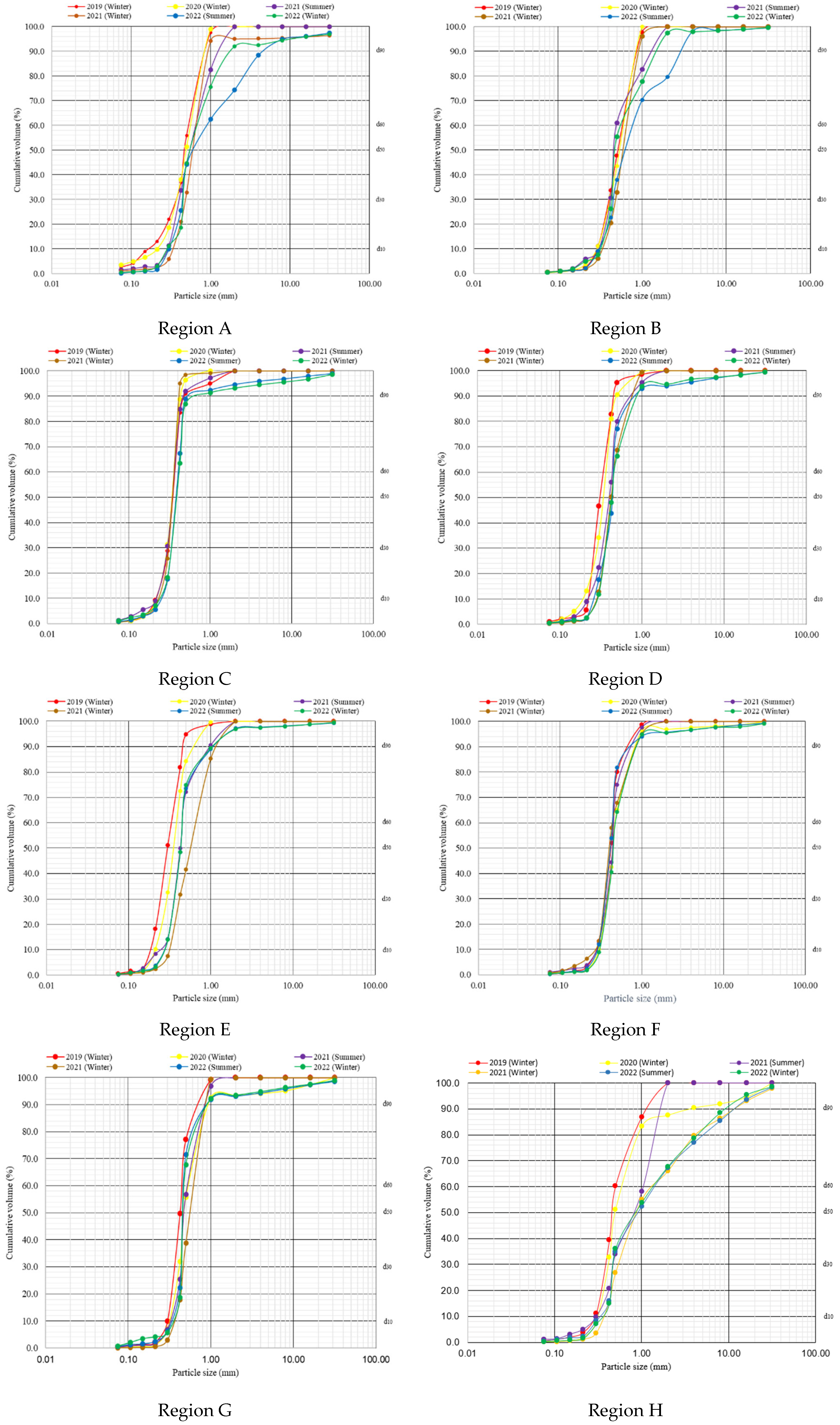
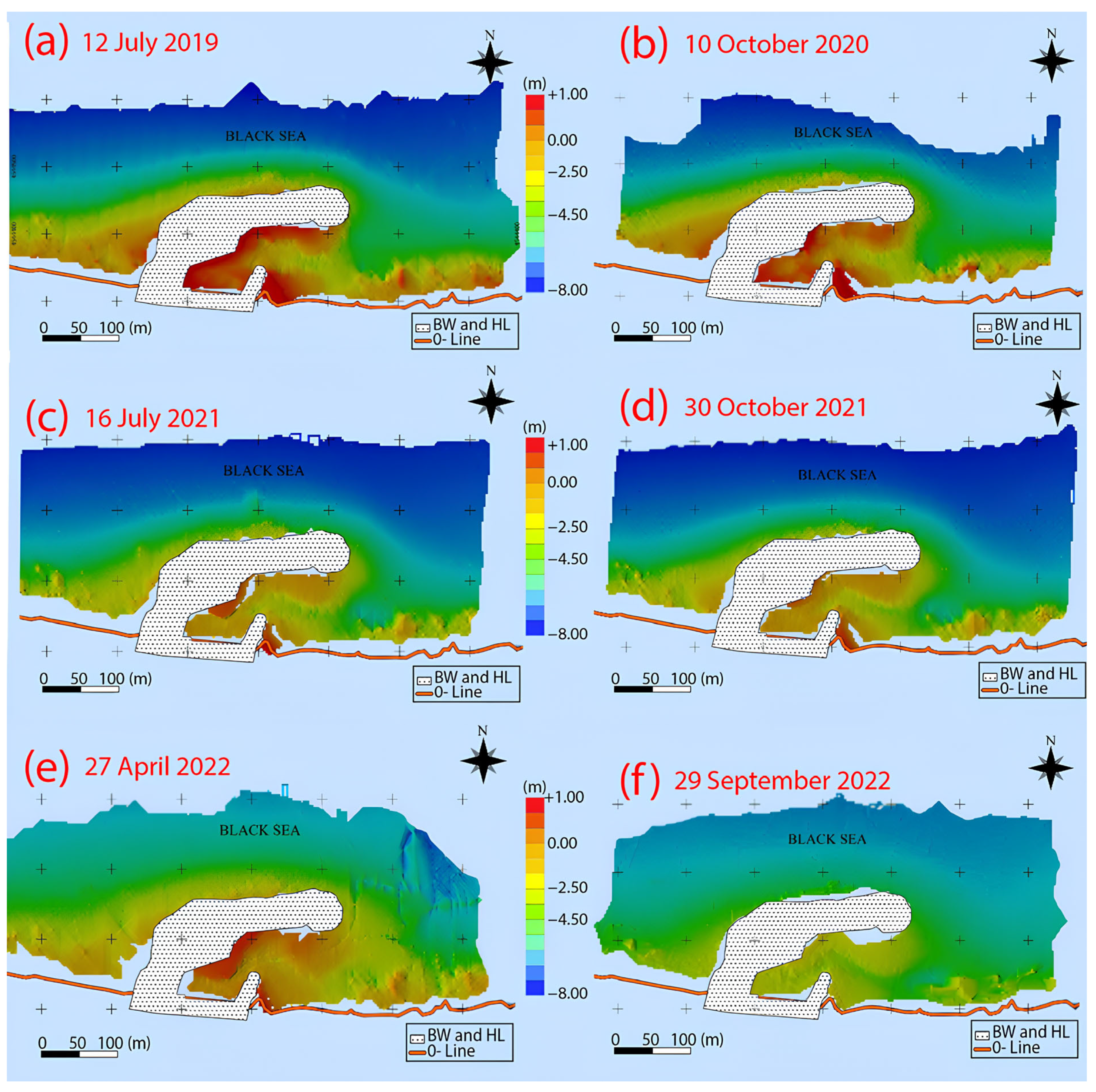

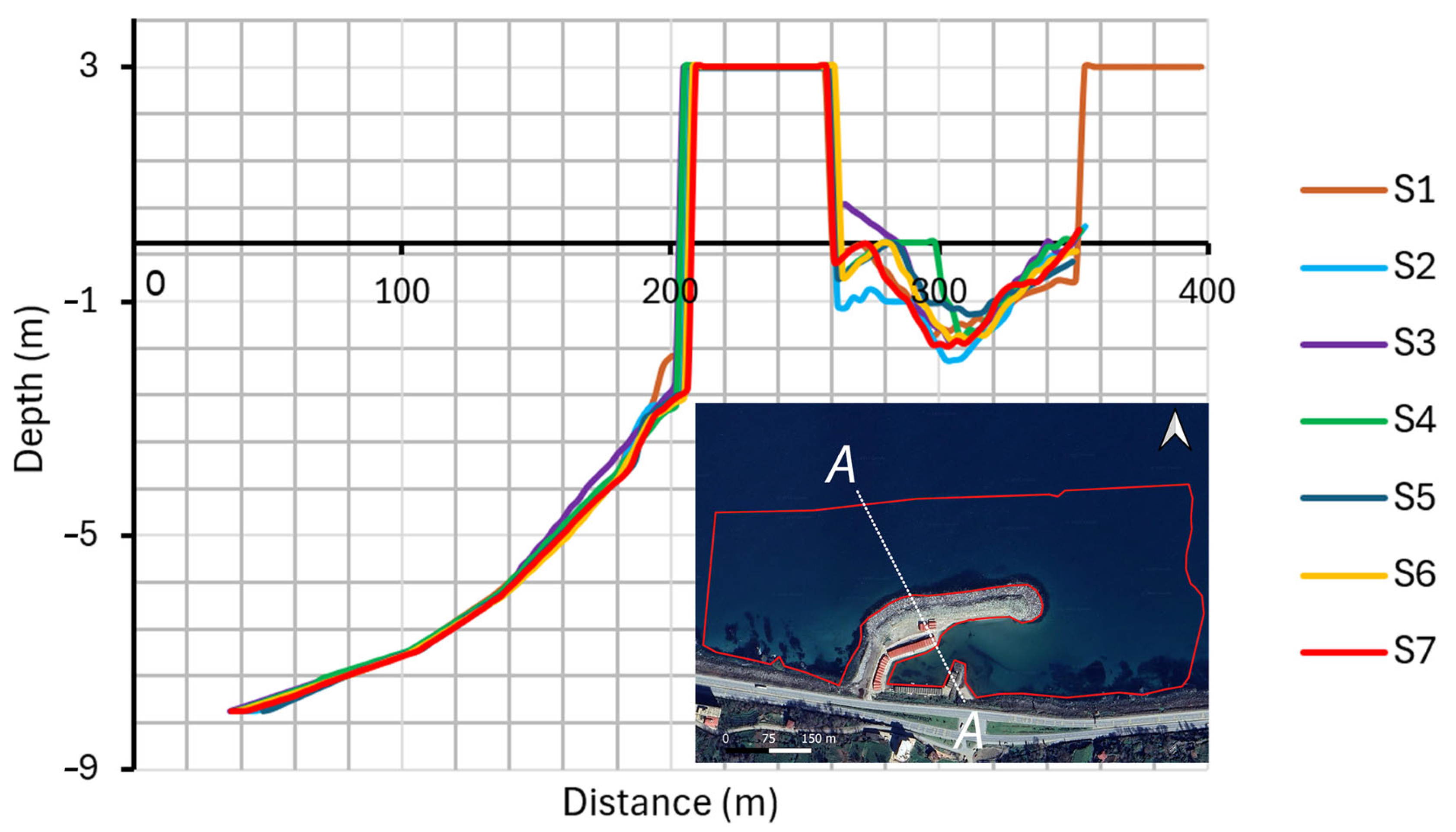
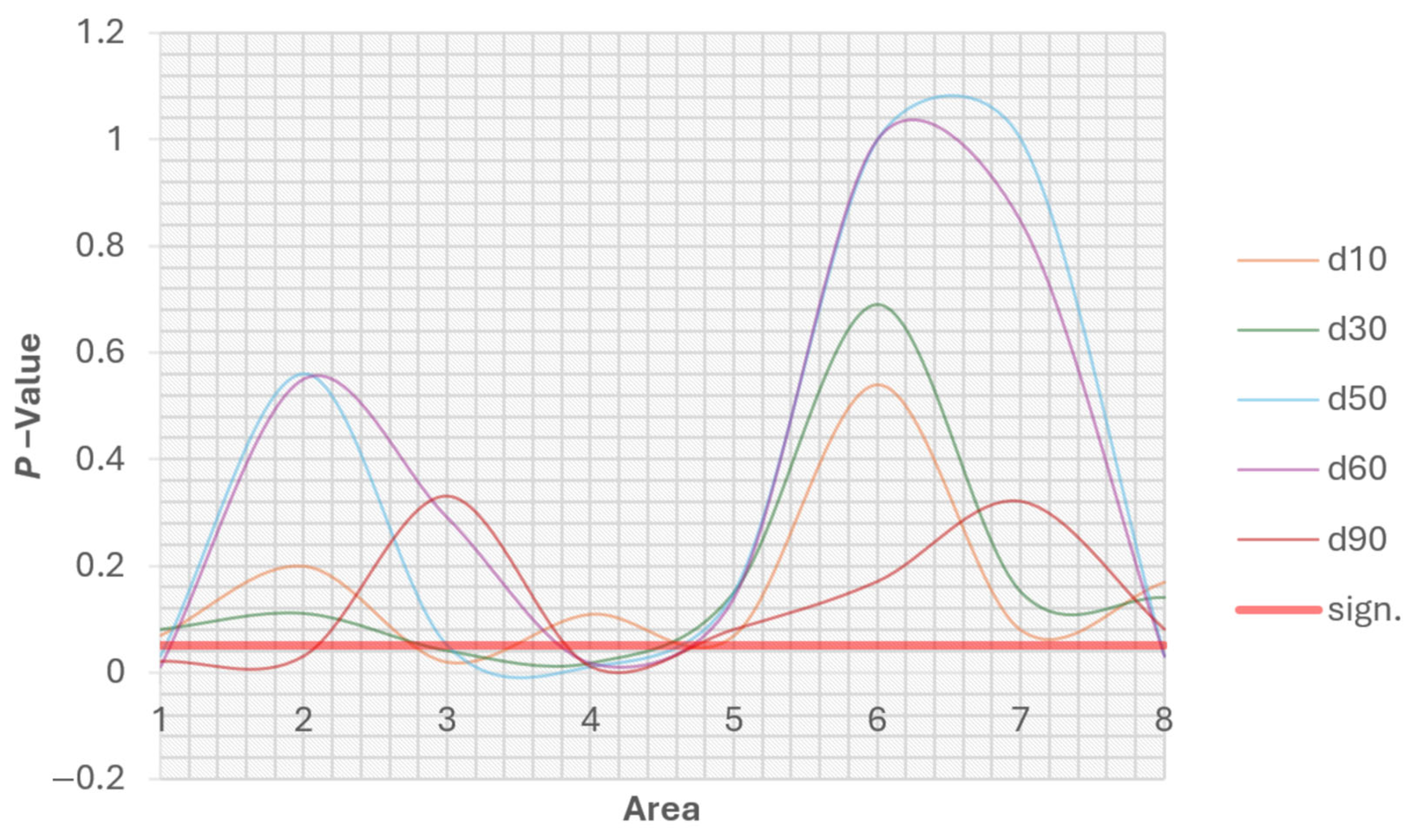
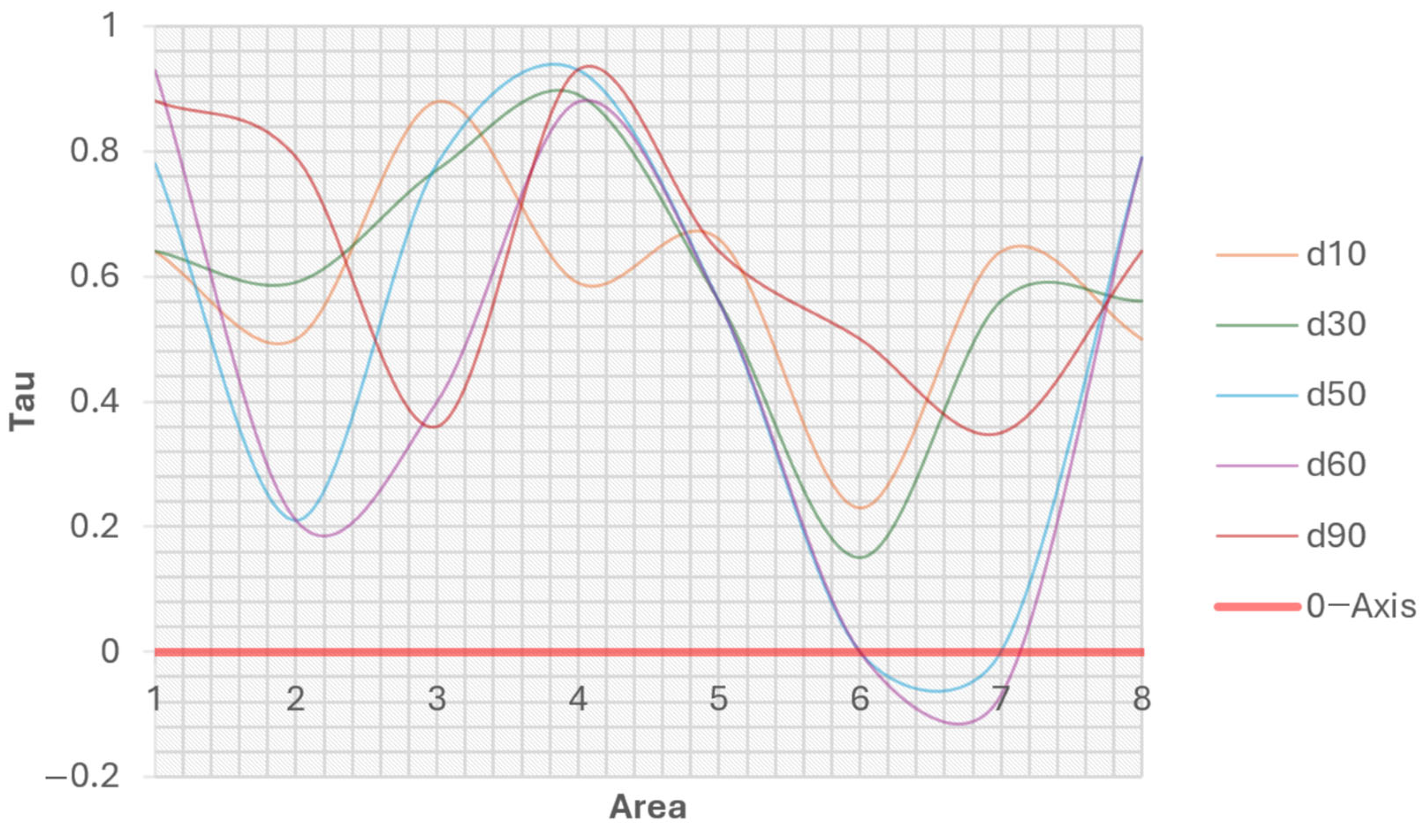
| Survey/Dredging No. | Date | Seasonal Explanation |
|---|---|---|
| D1 | 12 July 2019 | Summer |
| S1 | 12 November 2019 | Winter |
| S2 | 2 September 2020 | Winter |
| D2 | 1 October 2020 | Winter |
| S3 | 10 October 2020 | Winter |
| S4 | 16 July 2021 | Summer |
| S5 | 30 October 2021 | Winter |
| D3 | 2 January 2022 | Winter |
| S6 | 27 April 2022 | Summer |
| S7 | 29 September 2022 | Winter |
| Samp. Points | Date/Season | Sample Weight (gr) | d10 (mm) | d30 (mm) | d50 (mm) | d60 (mm) | d90 (mm) | Cu | Cc | USCS |
|---|---|---|---|---|---|---|---|---|---|---|
| Soil Class | ||||||||||
| A (1,2,3,4) | 2019 (winter) | 1336.1 | 0.16 | 0.36 | 0.48 | 0.53 | 0.88 | 3.31 | 1.53 | SP |
| 2020 (winter) | 1168.75 | 0.21 | 0.37 | 0.49 | 0.57 | 0.88 | 2.71 | 1.14 | SP | |
| 2021 (summer) | 940 | 0.28 | 0.4 | 0.55 | 0.66 | 1.35 | 2.36 | 0.87 | SP | |
| 2021 (winter) | 1171.6 | 0.33 | 0.48 | 0.61 | 0.68 | 0.95 | 2.06 | 1.03 | SP | |
| 2022 (summer) | 1015.6 | 0.3 | 0.44 | 0.62 | 0.91 | 4.73 | 3.03 | 0.71 | SP | |
| 2022 (winter) | 807.5 | 0.29 | 0.46 | 0.56 | 0.71 | 1.84 | 2.45 | 1.03 | SP | |
| B (5,6) | 2019 (winter) | 1104.16 | 0.29 | 0.4 | 0.52 | 0.59 | 0.9 | 2.03 | 0.94 | SP |
| 2020 (winter) | 1467.5 | 0.29 | 0.42 | 0.54 | 0.61 | 0.88 | 2.10 | 1.00 | SP | |
| 2021 (summer) | 1150.9 | 0.31 | 0.42 | 0.47 | 0.5 | 1.34 | 1.61 | 1.14 | SP | |
| 2021 (winter) | 1110 | 0.33 | 0.48 | 0.6 | 0.67 | 0.94 | 2.03 | 1.04 | SP | |
| 2022 (summer) | 1373.88 | 0.31 | 0.46 | 0.65 | 0.8 | 2.95 | 2.58 | 0.85 | SP | |
| 2022 (winter) | 1118.7 | 0.31 | 0.43 | 0.49 | 0.58 | 1.54 | 1.87 | 1.03 | SP | |
| C (7,8) | 2019 (winter) | 1315.96 | 0.21 | 0.3 | 0.34 | 0.37 | 0.49 | 1.76 | 1.16 | SP |
| 2020 (winter) | 1340 | 0.22 | 0.29 | 0.34 | 0.36 | 0.44 | 1.64 | 1.06 | SP | |
| 2021 (summer) | 285.3 | 0.22 | 0.3 | 0.34 | 0.36 | 0.48 | 1.64 | 1.14 | SP | |
| 2021 (winter) | 295.5 | 0.22 | 0.31 | 0.34 | 0.36 | 0.41 | 1.64 | 1.21 | SP | |
| 2022 (summer) | 451.98 | 0.24 | 0.33 | 0.38 | 0.4 | 0.61 | 1.67 | 1.13 | SP | |
| 2022 (winter) | 421.6 | 0.23 | 0.33 | 0.38 | 0.41 | 0.81 | 1.78 | 1.15 | SP | |
| D (9,10) | 2019 (winter) | 607.2 | 0.22 | 0.26 | 0.31 | 0.34 | 0.47 | 1.55 | 0.90 | SP |
| 2020 (winter) | 870 | 0.18 | 0.28 | 0.34 | 0.36 | 0.5 | 2.00 | 1.21 | SP | |
| 2021 (summer) | 1037.3 | 0.22 | 0.32 | 0.4 | 0.44 | 0.79 | 2.00 | 1.06 | SP | |
| 2021 (winter) | 687 | 0.27 | 0.35 | 0.42 | 0.46 | 0.81 | 1.70 | 0.99 | SP | |
| 2022 (summer) | 934.9 | 0.25 | 0.35 | 0.44 | 0.46 | 0.88 | 1.84 | 1.07 | SP | |
| 2022 (winter) | 724.2 | 0.28 | 0.36 | 0.43 | 0.47 | 0.91 | 1.68 | 0.98 | SP | |
| E (11,12,13,14) | 2019 (winter) | 635.8 | 0.18 | 0.24 | 0.3 | 0.33 | 0.47 | 1.83 | 0.97 | SP |
| 2020 (winter) | 998.75 | 0.21 | 0.29 | 0.35 | 0.38 | 0.65 | 1.81 | 1.05 | SP | |
| 2021 (summer) | 1115.9 | 0.23 | 0.35 | 0.43 | 0.46 | 0.98 | 2.00 | 1.16 | SP | |
| 2021 (winter) | 1051 | 0.31 | 0.41 | 0.57 | 0.67 | 1.25 | 2.16 | 0.81 | SP | |
| 2022 (summer) | 818.1 | 0.26 | 0.35 | 0.43 | 0.46 | 1.08 | 1.77 | 1.02 | SP | |
| 2022 (winter) | 797.9 | 0.26 | 0.35 | 0.43 | 0.46 | 1.06 | 1.77 | 1.02 | SP | |
| F (15,16) | 2019 (winter) | 770.7 | 0.27 | 0.35 | 0.42 | 0.45 | 0.72 | 1.67 | 1.01 | SP |
| 2020 (winter) | 956.3 | 0.3 | 0.37 | 0.45 | 0.48 | 0.87 | 1.60 | 0.95 | SP | |
| 2021 (summer) | 509.7 | 0.27 | 0.36 | 0.44 | 0.46 | 0.79 | 1.70 | 1.04 | SP | |
| 2021 (winter) | 256.5 | 0.25 | 0.34 | 0.4 | 0.44 | 0.88 | 1.76 | 1.05 | SP | |
| 2022 (summer) | 776.3 | 0.28 | 0.35 | 0.41 | 0.44 | 0.8 | 1.57 | 0.99 | SP | |
| 2022 (winter) | 936.45 | 0.3 | 0.38 | 0.45 | 0.49 | 0.9 | 1.63 | 0.98 | SP | |
| G (17,18,19,20,21,22) | 2019 (winter) | 825.2 | 0.3 | 0.36 | 0.43 | 0.46 | 0.75 | 1.53 | 0.94 | SP |
| 2020 (winter) | 818.89 | 0.31 | 0.41 | 0.48 | 0.54 | 0.95 | 1.74 | 1.00 | SP | |
| 2021 (summer) | 799.80 | 0.32 | 0.44 | 0.48 | 0.53 | 0.89 | 1.66 | 1.14 | SP | |
| 2021 (winter) | 690.84 | 0.35 | 0.47 | 0.57 | 0.64 | 0.9 | 1.83 | 0.99 | SP | |
| 2022 (summer) | 599.80 | 0.33 | 0.44 | 0.47 | 0.48 | 0.93 | 1.45 | 1.22 | SP | |
| 2022 (winter) | 632.50 | 0.34 | 0.44 | 0.47 | 0.49 | 0.94 | 1.44 | 1.16 | SP | |
| H (23,24,25,26) | 2019 (winter) | 921.20 | 0.29 | 0.38 | 0.46 | 0.5 | 1.18 | 1.72 | 1.00 | SP |
| 2020 (winter) | 979.90 | 0.31 | 0.41 | 0.49 | 0.61 | 3.64 | 1.97 | 0.89 | SP | |
| 2021 (summer) | 505.56 | 0.3 | 0.48 | 0.79 | 1.03 | 1.7 | 3.43 | 0.75 | SP | |
| 2021 (winter) | 868.75 | 0.36 | 0.54 | 0.89 | 1.37 | 11.57 | 3.81 | 0.59 | SP | |
| 2022 (summer) | 773.20 | 0.33 | 0.48 | 0.91 | 1.43 | 11.72 | 4.33 | 0.49 | SP | |
| 2022 (winter) | 1108.40 | 0.34 | 0.48 | 0.86 | 1.36 | 9.22 | 4.00 | 0.50 | SP |
| Measurement Dates | Bathymetric Change (m) | Volumetric Change (m3) | ||
|---|---|---|---|---|
| Erosion | Shoaling (Deposition) | Difference | ||
| 2019 (Winter)–2020 (Winter) | −0.04 | 10,987.89 | 6631.06 | −4356.83 |
| 2019 (Winter)–2021 (Summer) | 0.09 | 7997.08 | 21,089.22 | 13,092.14 |
| 2019 (Winter)–2021 (Winter) | 0.03 | 11,390.55 | 15,596.22 | 4205.67 |
| 2019 (Winter)–2022 (Summer) | 0.00 | 28,564.57 | 28,266.12 | −298.45 |
Disclaimer/Publisher’s Note: The statements, opinions and data contained in all publications are solely those of the individual author(s) and contributor(s) and not of MDPI and/or the editor(s). MDPI and/or the editor(s) disclaim responsibility for any injury to people or property resulting from any ideas, methods, instructions or products referred to in the content. |
© 2025 by the authors. Licensee MDPI, Basel, Switzerland. This article is an open access article distributed under the terms and conditions of the Creative Commons Attribution (CC BY) license (https://creativecommons.org/licenses/by/4.0/).
Share and Cite
Süme, V.; Yılmaz, E.; Marangoz, H.O.; Daneshfaraz, R.; Ebadzadeh, P.; Abraham, J.P. Shoaling and Sedimentation Dynamics in Fishery Shelters: A Case Study of Sandıktaş Fishery Shelter. J. Mar. Sci. Eng. 2025, 13, 779. https://doi.org/10.3390/jmse13040779
Süme V, Yılmaz E, Marangoz HO, Daneshfaraz R, Ebadzadeh P, Abraham JP. Shoaling and Sedimentation Dynamics in Fishery Shelters: A Case Study of Sandıktaş Fishery Shelter. Journal of Marine Science and Engineering. 2025; 13(4):779. https://doi.org/10.3390/jmse13040779
Chicago/Turabian StyleSüme, Veli, Enver Yılmaz, Hasan Oğulcan Marangoz, Rasoul Daneshfaraz, Parisa Ebadzadeh, and John Patrick Abraham. 2025. "Shoaling and Sedimentation Dynamics in Fishery Shelters: A Case Study of Sandıktaş Fishery Shelter" Journal of Marine Science and Engineering 13, no. 4: 779. https://doi.org/10.3390/jmse13040779
APA StyleSüme, V., Yılmaz, E., Marangoz, H. O., Daneshfaraz, R., Ebadzadeh, P., & Abraham, J. P. (2025). Shoaling and Sedimentation Dynamics in Fishery Shelters: A Case Study of Sandıktaş Fishery Shelter. Journal of Marine Science and Engineering, 13(4), 779. https://doi.org/10.3390/jmse13040779







